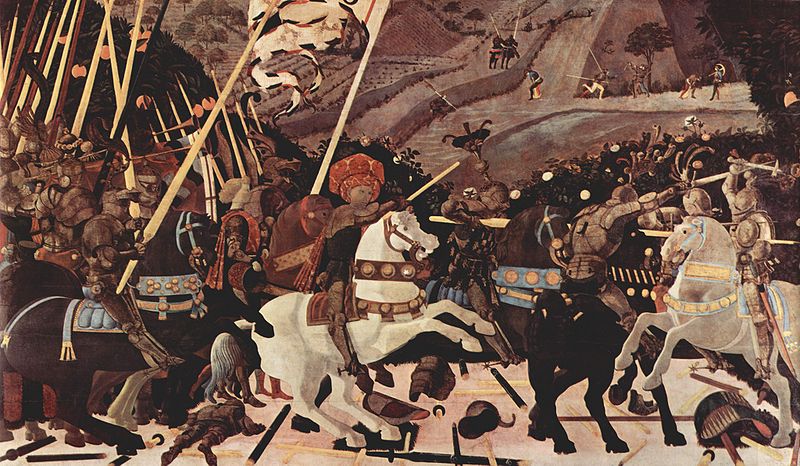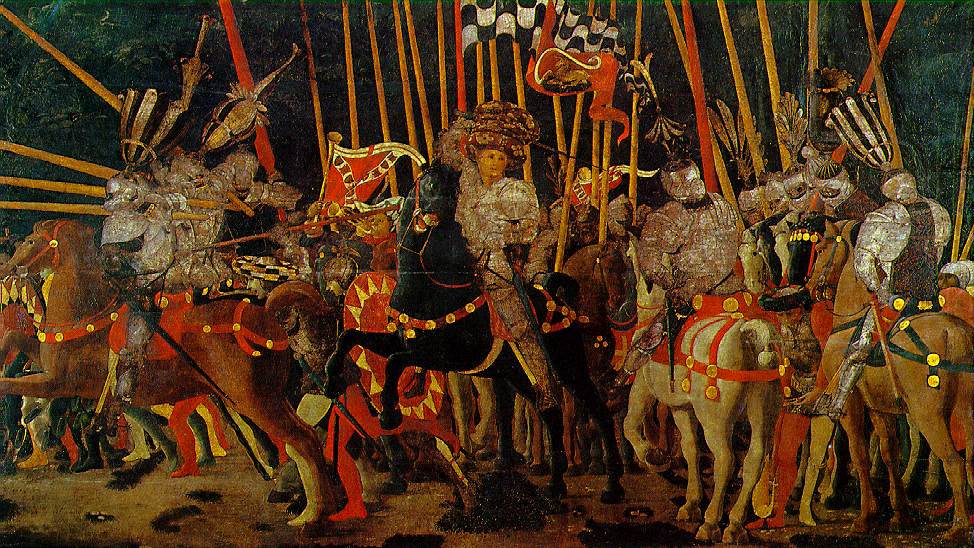2012 (286)
2013 (161)
2019 (2)



Niccolò Mauruzi da Tolentino unseats Bernardino della Ciarda at the Battle of San Romano: Paolo Uccello, c. 1435-1455 (Gallería degli Uffizi, Florence)

The Counterattack of Michelotto da Cotignola at the Battle of San Romano: Paolo Uccello, c. 1455 (Musée du Louvre, Paris)
The Battle of San Romano is a set of three paintings by the Florentine painter Paolo Uccello depicting events that took place at the Battle of San Romano between Florentine and Sienese forces in 1432. They are significant as revealing the development of linear perspective in early Italian Renaissance painting, and are unusual as a major secular commission. The paintings are in egg tempera on wooden panels, each over 3 metres long. According to the National Gallery,[1] the panels were commissioned by a member of the Bartolini Salimbeni family in Florence sometime between 1435 and 1460. The paintings were much admired in the 15th century; Lorenzo de' Medici so coveted them that he purchased one and had the remaining two forcibly removed to the Palazzo Medici. They are now divided between three collections, the National Gallery, London, the Galleria degli Uffizi and the Musée du Louvre, Paris.
The three paintings (from left to right) are:
- Niccolò Mauruzi da Tolentino at the Battle of San Romano (probably about 1438-1440), egg tempera with walnut oil and linseed oil on poplar, 182 × 320 cm, National Gallery, London.[2]
- Niccolò Mauruzi da Tolentino unseats Bernardino della Ciarda at the Battle of San Romano (dating uncertain, about 1435 to 1455), tempera on wood, 182 × 320 cm, Galleria degli Uffizi, Florence
- The Counterattack of Michelotto da Cotignola at the Battle of San Romano (about 1455), wood panel, 182 × 317 cm, Musée du Louvre, Paris
The Uffizi panel was probably designed to be the central painting of the triptych and is the only one signed by the artist. The sequence most widely agreed among art historians is: London, Uffizi, Louvre, although others have been proposed. They may represent different times of day: dawn (London), mid-day (Florence) and dusk (Paris) - the battle lasted eight hours.
In the London painting, Niccolò da Tolentino, with his large gold and red patterned hat, is seen leading the Florentine cavalry. He had a reputation for recklessness, and doesn't even wear a helmet, though he sent two messengers (the departure of the two messengers, depicted centre, top) to tell his allied army of Attendolo to hurry to his aid as he is facing a superior force.[3] In the foreground, broken lances and a dead soldier are carefully aligned, so as to create an impression of perspective. The three paintings were designed to be hung high on three different walls of a room, and the perspective designed with that height in mind, which accounts for many apparent anomalies in the perspective when seen in photos or at normal gallery height.
Many areas of the paintings were covered with gold and silver leaf. While the gold leaf, such as that found on the decorations of the bridles, has remained bright, the silver leaf, found particularly on the armour of the soldiers, has oxidized to a dull grey or black. The original impression of the burnished silver would have been dazzling. All of the paintings, especially that in the Louvre, have suffered from time and early restoration, and many areas have lost their modelling (wiki)



